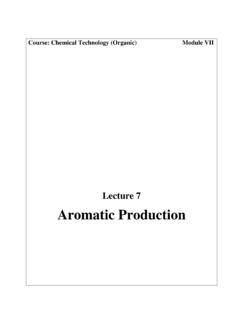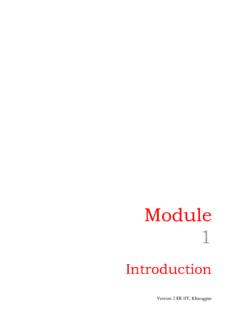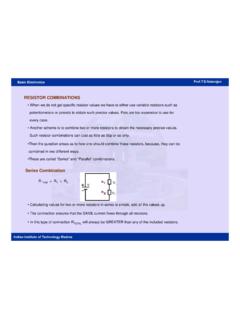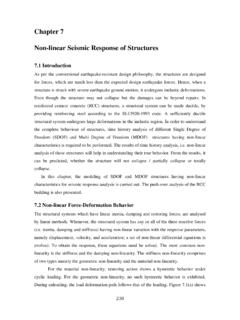Transcription of Download Free Lecture Notes-Pdf Link-I
1 Chapter 7 Vapour-Liquid Equilibria Introduction Both the general criterion of thermodynamic equilibrium as well as the specific condition of equality of chemical potential of each species which hold at equilibrium was introduced in the last chapter. We now develop the detailed relationships connecting the phase variables (T, P and composition) that originate from the concepts of chemical potential and the fugacity coefficient. The basic principle employed in all separation processes is that under equilibrium the compositions of phases differ from each other, and therefore it is possible to preferentially concentrate one species over another (or others). in one particular phase. This feature of phase equilibria is exploited in a wide variety of process equipments such as distillation, extraction, crystallization, etc.
2 This chapter focuses on the vapour-liquid equilibria (VLE) problem which is depicted schematically in fig. When a multi-component, vapour and liquid phase each (say) containing N. chemical species co-exist in thermodynamic equilibrium at a temperature T and pressure P, the phase compositions { y1, y2, .. y N 1} and { x1, x2, ..xN 1} remain invariant with time, and are related by a unique set of relations. If the relations are known as a function of temperature, pressure and compositions { yi and xi } for each species, then provided some of these variables are specified the rest may be calculated. We will derive such relations for real multi-component systems; but as in all cases of thermodynamic modeling we take the ideal system as our starting point.
3 Next the VLE of systems at moderate pressures are treated. Finally the relations for VLE at high pressures are presented. In the following section we derive the relations that hold for pure component VLE before describing those which apply to multi-component systems. Fig. The VLE Problem Description Single Component System Phase Equilibria We start with the general criterion of equality of the chemical potential in the two phases. To generalize the results we assume that any two types of phases and of a pure component are at equilibrium. Thus as given by eqn. : i = i ..( ). However, for a pure component the chemical potential is reduces to the pure component molar Gibbs free energy. Therefore: i = G and, i = G ..( ). Thus eqn. reduces to: G = G.
4 ( ). On taking a differential: dG = dG ..( ). Using the generic relationship in eqn. we may write in keeping with the fact that for a given equilibrium temperature, the equilibrium pressure corresponds to the saturation vapour pressure P sat : V dP sat S dT= V dP sat S dT ..( ). On rearranging: dP sat S S S . = =. dT V V V ..( ). Additionally using the second law we have: dS = dQ T..( ). And that for a constant pressure process: dQ = dH..( ). Using eqns. ( ) and ( ) we obtain: H =. T S ..( ). Thus, S =. H / T , and substitution in gives: dP sat H . = ..( ). dT T V . The last equation is called the Clapeyron equation. For the specific case of phase transition from liquid (l) to vapor (v), it translates into: dP sat H LV. = ..( ). dT T V LV. Noting that liquid phase molar volumes are relatively much lesser than vapour phase volumes, we may write, V LV = V V V V V v.
5 ( ). Further at low to moderate saturation pressures if we assume ideal vapour phase behaviour, then RT. Vv . P sat ..( ). Eqn. then becomes: dP sat H LV. =. dT RT / P sat Or: dP sat / P sat H LV. = ..( ). dT / T 2 R. d ln P sat Whence, H LV =. R[ ] ..( ). d (1/ T ). This approximate equation is known as the Clausius-Clapeyron equation. The assumptions used in the above derivations have approximate validity only at low pressures. Integrating eqn. we have: B. ln P sat= A ..( ). T. On comparing eqns. and , it follows that: B = H LV / R, while A is the constant of integration. These are generally regarded as constants for a given species. A plot of experimental values of lnPsat vs. 1/T generally yields a line that is nearly straight between the triple and critical points.
6 However, the validity of eqn. questionable at relatively high pressures, and certainly in the critical region. Thus the accuracy of the Clausius-Clapeyron equation reduces at higher pressures. A modified form of eqn. , called the Antoine Equation, has proved to be more accurate (including at higher pressures), has the following form: B. ln P sat= A ..( ). T +C. A, B, and C are readily available for a large number of species. Appendix VI provides values of Antoine constants for select substances. More complex forms of equations relation temperature and vapour pressure of pure substances have been reported in the literature, which provide even greater accuracy. An example of such an equation is the Wagner equation, which is given by: A + B + C 3 + D 6.
7 Ln Prsat = , where = 1 Tr ..( ). 1 . The constants for the Wagner equation for specific substances are available in several reference texts (see Reid, Prausnitz and Poling, Properties of Gases and Liquids, 4th ed., McGraw- Hill, 1987). Derivation of the Phase Rule The phase rule was introduced in section without proof. Here we develop its mathematical form based on the tenets of solution thermodynamics and phase equilibrium criterion presented in the last chapter. Consider a non-reactive system under equilibrium, with phases each containing N. independent chemical species. The degrees of freedom for the system, , the number of intensive variables that may vary independently of each other would be given by: Degrees of freedom = Total number of systemic intensive variables number of independent equations relating all the variables.
8 For the system of interest here the above terms are as follows: I. Total number of systemic intensive variables (also called the phase rule variables)= T, P and (N-1) species mole fractions for each of the phases II. Number of independent relations connecting the phase rule variables = ( 1)N. The second relation above follows from the fact that for each of the N species one may use the chemical potential equality relation across all phases, as described by eqn. It follows that for each component there can be only ( 1) independent relations. Thus the phase rule may be rewritten as: F =[ 2 + ( N 1) ] [ ( 1) N ] =2 + N ( ). It may be noted that the actual mass of each of the species present are not considered as phase rule variables, as they cannot influence the intensive state of the system.
9 A special case of the phase rule obtains for closed systems for which the initial mass for each species is fixed . Since no mass can enter or leave the system, the extensive state of the system is rendered fixed along with the intensive variables. Therefore, apart from the ( 1)N constraining relations involving the species chemical potentials, there is an additional [ ( N 1) ] constraint on the mass of each species; this follows from the fact that if a quantum of a species leaves a phase it must reappear in another or more. Thus the phase rule eqn. leads to: F =[ 2 + ( N 1) ] [ ( 1) N ] [ ( N 1) ] =2 ..( ). The above equation is known as the Duhem's theorem. It implies that for any closed system formed initially from given masses of a number of chemical species, the equilibrium state is completely determined when any two independent variables are fixed .
10 The two independent variables that one may choose to specify may be either intensive or extensive. However, the number of independent intensive variables is given by the phase rule. Therefore, it follows that when F = 1, at least one of the two variables must be extensive, and when F = 0, both must be extensive. '. Description of General VLE Behavior Before presenting the mathematical formulation of the multi-component VLE problem it is pertinent to discuss some key features of typical vapour liquid phase behaviour. The description of phase behaviour of vapour and liquid phases co-existing under equilibrium can be complex and difficult to visualize for systems containing a large number of chemical species. Thus, to clarify matters it is useful to consider a binary system.









